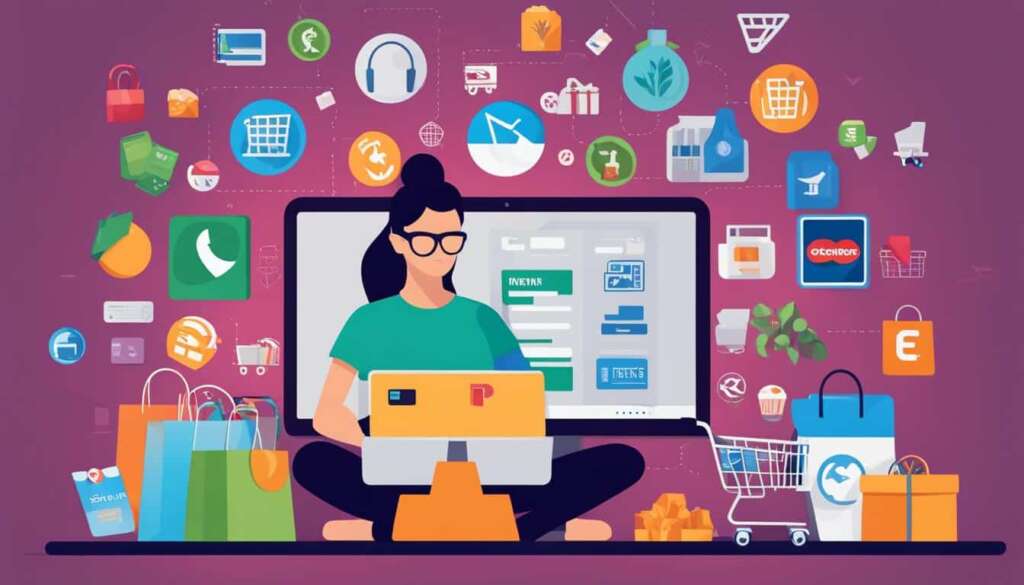Table of Contents
E-commerce, also known as electronic commerce, refers to the buying and selling of goods and services over the internet. It involves transactions that occur online, where customers use electronic devices to access online stores and make purchases. E-commerce encompasses various activities such as buying physical products, accessing digital services, and transmitting funds or data electronically.
With the rise of e-commerce platforms like Amazon and eBay, online retail has experienced significant growth over the years. In 2011, e-commerce accounted for 5% of total retail sales, but due to the COVID-19 pandemic, it rose to 16.5% in Q2 2020.
How Does E-Commerce Work?
E-commerce is driven by the internet and operates through online stores where customers can browse and order products and services using their devices. The process involves several key components and stages that work together seamlessly to facilitate transactions.
1. Online Stores
At the heart of e-commerce are online stores, which serve as virtual marketplaces where customers can explore a wide range of products and services. These stores are accessible through web browsers, enabling customers to search for items, view details, and make purchases from the comfort of their own homes.
2. Web Browser and Server
Once customers find the desired product or service, their web browser initiates communication with the server hosting the e-commerce website. This interaction enables the transfer of information and data necessary for completing the transaction.
3. Order Manager and Databases
Upon placing an order, the customer’s request is relayed to an order manager. The order manager then coordinates with databases that oversee inventory management and payment processing. These databases ensure that the product is available and that the necessary financial information is securely stored.
4. Payment Processing
Secure payment processing is a vital aspect of e-commerce. Once the order manager confirms the availability of the product and verifies the customer’s payment information, the payment is processed, ensuring a secure and seamless transaction.
5. Fulfillment Process
The fulfillment process involves the coordination of various activities, including packaging, shipping, and delivering the product to the customer. Once the order manager confirms payment, the fulfillment department is notified to prepare the item for dispatch. This stage plays a crucial role in ensuring timely delivery and customer satisfaction.
6. E-Commerce Platforms
E-commerce platforms offer businesses the tools and infrastructure required to facilitate e-commerce transactions. These platforms come in various forms, including online marketplaces, software as a service (SaaS) tools, and open-source solutions. They provide a framework for businesses to manage their online stores and streamline the e-commerce process.
“E-commerce is a dynamic ecosystem that operates through a network of internet-enabled devices and platforms, connecting customers and businesses worldwide.”
E-commerce relies on a well-orchestrated process that encompasses web browsing, server communication, order management, database utilization, payment processing, and fulfillment. The combination of these elements ensures a smooth and efficient online shopping experience for customers.
Types of E-Commerce
E-commerce transactions can be classified into different types based on the parties involved. In this section, we will explore the various categories of e-commerce and their unique characteristics.
B2B (Business-to-Business)
B2B e-commerce refers to transactions that occur between businesses. It involves the exchange of products, services, or information to meet the specific needs of other businesses. B2B transactions often involve bulk orders, long-term contracts, and close collaboration between suppliers and buyers. This type of e-commerce is commonly found in industries such as manufacturing, wholesale trade, and professional services.
B2C (Business-to-Consumer)
B2C e-commerce involves businesses selling products, services, or information directly to consumers. This is the most familiar type of e-commerce, where businesses establish online stores or marketplaces to reach individual customers. B2C transactions are typically characterized by smaller order sizes, a wide variety of products, and the ability for consumers to compare prices and make informed purchasing decisions.
D2C (Direct-to-Consumer)
D2C e-commerce refers to businesses that manufacture or produce goods and sell them directly to consumers. By bypassing traditional retail channels, these companies can establish stronger relationships with their customers and offer unique branded experiences. D2C brands have gained popularity in industries such as fashion, beauty, and home goods, where they can showcase their products’ quality and authenticity more effectively.
C2C (Consumer-to-Consumer)
C2C e-commerce involves consumers trading products, services, or information with each other. Online platforms and marketplaces enable individuals to buy and sell between themselves, acting as intermediaries that facilitate transactions and ensure trust and security. C2C e-commerce is prevalent in the sharing economy, secondhand markets, and peer-to-peer services.
C2B (Consumer-to-Business)
C2B e-commerce is the reverse of traditional B2C transactions. In this model, consumers make their products or services available for businesses to bid on and purchase. It empowers individuals to monetize their skills, expertise, and resources, offering unique value propositions to businesses. C2B e-commerce is often seen in freelance platforms, influencer marketing, and user-generated content marketplaces.
B2A (Business-to-Administration) and C2A (Consumer-to-Administration)
B2A and C2A e-commerce involve interactions between businesses or consumers and public administration or government bodies. B2A transactions can include online licensing, tax filing, or procurement processes for businesses, while C2A transactions may involve online registrations, public service payments, or submitting documentation as a consumer.
Mobile Commerce (m-commerce)
Mobile commerce, also known as m-commerce, refers to online sales transactions conducted through mobile devices such as smartphones and tablets. With the increasing popularity of mobile devices, m-commerce has become an essential part of e-commerce. Consumers can make purchases, access online services, and engage with businesses using dedicated mobile applications or mobile-optimized websites.
Understanding the different types of e-commerce is crucial for businesses and consumers alike. Each category has its unique characteristics, opportunities, and challenges, paving the way for a diverse and dynamic digital marketplace.

Advantages and Disadvantages of E-Commerce
E-commerce offers numerous advantages that have contributed to its widespread adoption and success. Understanding the benefits and drawbacks of this digital marketplace can help businesses make informed decisions about their online presence.
Advantages of E-Commerce
- Availability: E-commerce provides 24/7 access to products and services, allowing customers to shop at their convenience.
- Accessibility: With just a few clicks, customers can access online stores from anywhere in the world, eliminating the need for physical travel.
- Speed of Access: E-commerce platforms allow customers to browse and purchase products quickly, reducing the time taken compared to traditional shopping methods.
- Selection: Online stores offer a vast selection of products and services, giving customers a wide range of options to choose from.
- International Reach: E-commerce provides businesses with the opportunity to reach and sell to a global audience, breaking down geographical barriers.
- Lower Cost: Operating an online store typically incurs lower costs compared to maintaining a physical storefront, resulting in potential cost savings.
- Personalization: Through data analytics and targeted marketing, e-commerce platforms can personalize product recommendations and marketing campaigns, enhancing the customer experience.
Disadvantages of E-Commerce
- Limited Customer Service: E-commerce platforms often lack the personal interaction and immediate support that customers may experience in physical stores.
- Lack of Product Experience: Unlike traditional retail, e-commerce does not allow customers to physically touch, try, or experience products before purchasing, potentially reducing customer satisfaction.
- Wait Time: The delivery of products purchased online can take time, resulting in a waiting period for customers, especially if expedited shipping options are not available.
- Security: E-commerce transactions involve the exchange of sensitive personal and financial information, leaving customers vulnerable to potential security breaches and fraud.
Despite these challenges, e-commerce continues to grow in popularity and offers significant opportunities for businesses. By leveraging the advantages and addressing the drawbacks, businesses can harness the power of this digital marketplace to enhance their reach, increase sales, and provide customers with a convenient and seamless shopping experience.
Conclusion
E-commerce has revolutionised the way people shop and do business online. With its various business models, companies can now reach customers globally and offer a wide range of products and services. The advantages of e-commerce are numerous, including increased accessibility, convenience, a vast selection of goods and services, lower costs, international reach, and the ability to personalise marketing efforts. However, there are also some disadvantages to consider, such as limited customer service, the lack of physical product experience before purchase, longer wait times for shipping, and security concerns.
Despite these challenges, e-commerce continues to shape the retail industry, providing businesses with opportunities to expand their reach and serve customers in new and innovative ways. The convenience of online shopping and the ability to find products from across the globe at competitive prices have significantly impacted consumer behavior. Moreover, the ease of setting up an online store has made it possible for entrepreneurs to launch their businesses without the need for a physical presence.
As e-commerce continues to evolve, businesses must adapt and leverage its advantages while addressing the disadvantages effectively. Providing reliable customer service, enhancing product descriptions and images to bridge the gap of physical experience, optimizing supply chains to reduce shipping times, and prioritizing data security measures are crucial steps in overcoming the challenges. By doing so, companies can tap into the immense potential of e-commerce and thrive in the digital marketplace.
FAQ
What is e-commerce?
E-commerce, also known as electronic commerce, refers to the buying and selling of goods and services over the internet.
How does e-commerce work?
E-commerce operates through online stores, where customers use their devices to browse products, place orders, and communicate with servers hosting the websites.
What are the types of e-commerce?
There are various types of e-commerce, including B2B, B2C, D2C, C2C, C2B, B2A, C2A, and mobile commerce (m-commerce).
What are the advantages of e-commerce?
E-commerce offers 24/7 availability, easy access for customers, a wide selection of products, international reach, lower operating costs, and the ability to personalize marketing.
What are the disadvantages of e-commerce?
Disadvantages include limited customer service, the inability to physically experience a product before purchase, wait times for product shipping, and potential security issues.







